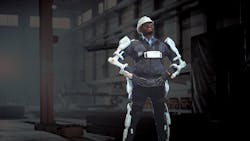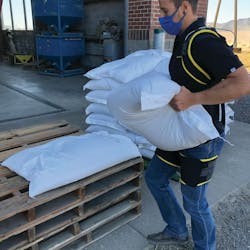A Weighty Proposition: Exoskeletons in the Workplace
Major corporations, such as Toyota, Ford, and Boeing, have begun adding exoskeletons to their operational toolbox over the last few years. They have gone deep; generously shared their learnings; and reported some encouraging results, including positive worker feedback, less exertion, less discomfort, and even reduced injuries and workers’ compensation costs when using exoskeletons.
Many smaller companies in industries ranging from logistics to construction to agriculture to manufacturing have also begun using exoskeletons since this technology has become more practical, approachable, and affordable.
At the core of exoskeleton technology is a simple concept: address potentially painful problems before they actually become a problem.
Overexertion continues to be a leading cause of pain, physical disability, missed work, lost productivity, turnover, and medical expenses. According to the Centers for Disease Control and Prevention, back pain is the most prevalent work-related health problem. The Occupational Safety and Health Administration estimates that employers pay nearly $1 billion for direct workers’ compensation. That’s why exos (rigid exoskeletons and flexible, textile-based exosuits) are becoming a popular investment to ensure worker safety, well-being and productivity.
Companies that are successfully integrating exo technology into their workflow have been purposeful in matching the right type of device to the right job. Some organizations consider exos to be tools while others consider them to be PPE or even a form of engineering control.
Regardless, these companies have discovered that effective exo technology is built on three pillars: comfort, assistance, and freedom of movement. You need all three working in unison to get the most out of an exo.
After years of experience in designing, testing, and implementing occupational exos, we’ve identified a list of key questions for occupational health and safety professionals to ask when exploring the use of exos to sustain and support the hardworking women and men in their organizations.
1. Have you Explored Traditional Ergonomic Controls?
Ergonomics and safety efforts have been very effective in reducing injury rates over the last few decades. The Hierarchy of Controls is an effective approach for reducing risk that has helped tremendously. Proactively preventing injuries is always better than reacting to them for both employees and employers.
Despite excellent progress, there are still work-related injuries. In a perfect world, there would be none. National Safety Council’s Work to Zero Initiative aims to eliminate workplace fatalities through the use of technology.
A similar initiative to reduce work-related injuries could be very helpful, especially one aimed at reducing preventable work-related musculoskeletal disorders (WMSDs) such as sprains and strains, which can be debilitating and costly for people and companies alike.
Previous injuries are the top predictor of future injuries. That’s why it’s critical to prevent as many injuries as possible in the first place. It’s also important to reduce the cumulative wear and tear many workers experience as they age.
Exos can help reduce strain, fatigue, and injury risk in the workplace. They are a complementary new tool in the ergonomics and safety toolbox that can be utilized with traditional engineering, administrative and behavioral controls.
Exos are becoming part of a comprehensive health, ergonomics, and safety program. They are not a replacement for good ergonomics. If everything has been done to improve the ergonomics of a job but risk factors for overexertion, fatigue, injuries or turnover persist, then exos might be worth exploring.
2. Where Do Your Workers Need Help?
There are many types of exoskeletons, including ones that specialize in supporting certain body parts or functions. For example, there are shoulder-assist exoskeletons. Toyota uses such an exoskeleton for its workers who are frequently working overhead on the assembly line. There are also back-assist exosuits that provide low-back support and assistance for workers who lift, bend and reach throughout their shift.
Consider the primary movements of your workers, what injuries are prevalent or where your workers are sore day in and day out. Then look into the exos that provide that kind of support.
3. Are Your Workers Interested in Relief? Are Managers Open to New Ideas?
Culture is an important factor in the successful adoption of exos. It will be much easier to implement exos if workers and managers are interested and have bought in. First, ask workers and managers if they are familiar with occupational exos. This is an emerging tech, and they may not realize practical workplace exos exist. They may also have erroneous preconceptions based on Hollywood movies or an exo they tried five years ago and did not like.
Much like early cell phones, there’s no comparing modern exos to those previous models. There have been major advances in the last five to 10 years, including models that are much lighter weight, lower profile, and more like clothing (exosuits). Exos are not as clunky and obstructive as they used to be. Most now use springs, rather than motors and batteries to assist, which has made exos much more affordable.
It’s not impossible to implement exos if your workers are not initially interested in exos (particularly if they are not aware of the newest tech), but it can be more difficult. Communicating with and educating workers and other stakeholders will be critical. Question 7 discusses how exo implementation experts can help your organization build awareness of exos and increase worker buy-in.
4. What Tasks Would Benefit Most and How Long Do Workers Perform These Each Day?
Identifying the pain point tasks in your workplace will help make sure you are looking at the right types of exos (e.g., shoulder vs. back). Even within back exos, there are models that excel for more static jobs that involve lots of bending (e.g., a worker bent over a conveyor belt) and others designed for highly dynamic jobs that involve lots of lifting, stooping, walking or other tasks (e.g., case picker, aerial porter and construction worker).
You also need to understand how often exo assistance would be needed. Will your workers only need to use an exo for the most strenuous tasks or all day for 40-plus hours per week?
Knowing the answers to these questions helps narrow potential exo solutions. Some are great for short stints but can be uncomfortable or obstructive for long durations. Others have been optimized for longer use and can accommodate all sorts of tasks and postures without getting in the way. If workers are going to be using it all day, it better be light and comfortable. If they are going to take it on and off, then it better don/doff in seconds.
5. Is There Evidence the Exo You’re Considering Actually Works?
There is a large body of evidence that exos (as a general class of device, including rigid, soft, active, passive, and quasi-passive devices) assist workers and relieve strain on the body—and not just by transferring loads elsewhere (see sidebar, “Common Misconceptions about Exo Technology”). But you still have to do your homework.
When considering models, review lab-based validation studies and field tests.
Look at the quality of evidence as well. Is it a random plot on a webpage without any source for the data or is it peer-reviewed science with supporting evidence from multiple studies?
And watch out for posture aids masquerading as exos. There are devices that provide tactile feedback to remind workers to use good posture (similar to back belts), but true exos are a very different class of device.
Exos can both promote good posture and substantially offload the muscles and bones. This offloading benefit is what distinguishes exos from back belts and posture aids and why exos reduce overexertion injury risks.
6. Will a Given Exosuit Fit Your Entire Workforce Comfortably, Safely, and Without Interfering With Other Job Tasks?
Most companies that explore exos start with a pilot test on a small number of workers, often about 2 to 50, to assess effectiveness, worker acceptance, and the likelihood an exo can fit into their workflow.
But before you bring in a new exo, or any new tech, be sure to think it through. If the first workers love this exo, then would this solution be feasible to roll out and scale to the rest of your workforce?
It’s best to know this upfront. For instance, consider the cost and whether the exo will fit people of different sizes, shapes, and genders. Don’t assume that all exos fit women’s bodies; this has long been a problem for exoskeletons and other types of PPE. But this is changing, and there are now companies offering specific versions of exos for women.
You also need to consider if there are any other environmental constraints with respect to safety, such as extreme heat or cold, electrical hazards, dirty/dusty environment, sensitive equipment, and confined spaces? Would the exo you are considering be able to hold up in this environment, or would it get in the way? Can workers quickly don/doff if they need to use the bathroom, or turn off the exo and still be comfortable if they have a short break or need to hop in a forklift?
As important as it is to identify the tasks that need assistance, it is equally important to identify the tasks that do not. Do your workers need to sit down occasionally, climb ladders, get on their knees, walk, run or enter confined spaces? Movement interference has been one of the largest barriers to exoskeleton adoption. This has historically been a challenge for wearable assist devices, but some modern exos are using soft textiles, lightweight designs, and get-out-of-the-way (on/off) modes to ensure worker freedom of movement. It’s truly the beginning of a new era for exos.
7. Does the Exo Vendor Provide Training and Implementation Support Beyond the Product Sale?
There are a number of considerations for successful implementation depending on the size of your organization, the industry, and other internal dynamics. If your organization is new to exos, you likely would benefit from advice and guidance on implementation from a vendor that has been implementing exos for years.
A few key questions to ask: How do you prepare for implementation before exos arrive on-site? Who is needed to support new exoskeleton users? How do you make sure a given exo fits well and continues to fit well over time? How will exos be maintained, stored, and cleaned to ensure safe and sanitary use?
8. What Does Success Look Like for Your Organization?
As safety professionals, you have to be in the driver’s seat for this. Exos are not about technology. They are about people and organizations—keeping people healthy and energized, and organizations intact and productive.
You should understand up front: What does success look like? What metrics or factors will your organization use to assess success? Do you have the support needed to roll out exos more broadly if your workers respond enthusiastically?
Also, does everyone in your organization understand that the goal is not for workers to wear exoskeletons so they can handle heavier things? The goal is to protect workers from injury risks, not push them harder.
If you are new to exos, you ideally want support from EHS personnel, management, the workers themselves, and also external guidance (e.g., exo vendor) on implementation support.
Parting Thoughts
There’s a lot to consider when exploring exos to supplement and expand your occupational health and safety toolbox. However, exos have never been more practical and approachable.
Sites like ExoskeletonReport.com offer balanced, valuable, and accessible information for those interested in learning more about exoskeletons and exosuits.
Exos are now available that can help companies promote a healthier and safer workplace in ways that make financial sense, too.
Active workers are now able to work better—and safer—at their jobs and live better away from them, too.
Sidebar: Common Misconceptions about Exoskeleton Technology
Because exoskeletons (exos) are still relatively new to the market, there are some prevailing misconceptions about them.
Do Exos Cause Atrophy?
To date, there is no evidence that exos have caused or will cause, muscles to atrophy. For instance, employees in warehouses have to lift and move 25-pound boxes. For workers wearing exosuits, they feel more like 15-lb. boxes. These jobs still require plenty of effort, but even slight reductions in strain and fatigue can make a significant difference to workers’ health and well-being, especially over time.
And a little-known fact: Muscle atrophy can actually occur when there is too little or too much muscle activation. That means overexertion can lead to muscle atrophy, as can the lack of muscle use after an injury. The purpose of exos is to keep workers in that healthier “sweet spot.”
Do Exos Just Shift Forces to Other Parts of the Body?
No, this is a misconception of how exos function. Exos use leverage to do the mechanical work more efficiently. They allow your body to do the same amount of physical work—for instance, to lift a box—but with lower forces applied to bones, muscles, and joints.
Most exos also are not meant to encourage employees to do even more work. They are designed to reduce the risk for injury, help combat overexertion and fatigue over the course of a work shift and, quite simply, improve people’s lives.
About the Author

Karl Zelik, Ph.D.
Chief Scientific Officer & Co-Founder — HeroWear
Karl Zelik, Ph.D. is an associate professor of mechanical engineering at Vanderbilt University, where he co-directs the Center for Rehabilitation Engineering and Assistive Technology.
Dr. Zelik is co-founder and chief scientific officer of occupational exosuit maker HeroWear. He also serves on the board of the non-profit American Bionics Project, performs biomechanics and wearable technology consulting work via Zelik Biomech, and has contributed to the development of exo industry standards as part of the ASTM F48 committee.
Matthew Marino
Matthew Marino, PT, MSPT, CPE, is director of ergonomics and human factors at HeroWear. He has been an active member of the ASTM F48 Committee on Exoskeletons and Exosuits since its inception and is a founding partner of the ASTM Exo Technology Center of Excellence.


